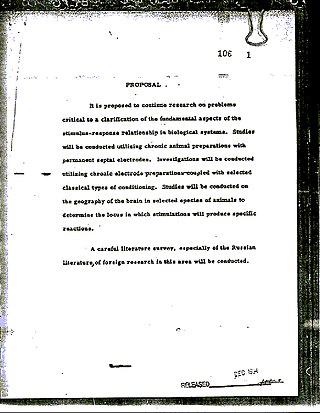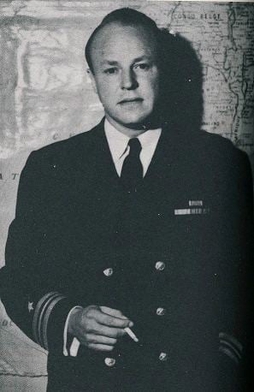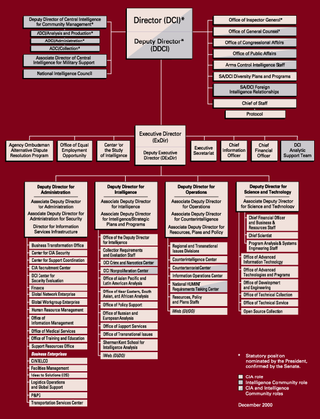Related Research Articles

The Office of Strategic Services (OSS) was the intelligence agency of the United States during World War II. The OSS was formed as an agency of the Joint Chiefs of Staff (JCS) to coordinate espionage activities behind enemy lines for all branches of the United States Armed Forces. Other OSS functions included the use of propaganda, subversion, and post-war planning.

Project MKUltra was an illegal human experimentation program designed and undertaken by the U.S. Central Intelligence Agency (CIA) and intended to develop procedures and identify drugs that could be used during interrogations to weaken people and force confessions through brainwashing and psychological torture. It began in 1953 and was halted in 1973. MKUltra used numerous methods to manipulate its subjects' mental states and brain functions, such as the covert administration of high doses of psychoactive drugs and other chemicals without the subjects' consent, electroshocks, hypnosis, sensory deprivation, isolation, verbal and sexual abuse, and other forms of torture.
CIA cryptonyms are code names or code words used by the U.S. Central Intelligence Agency (CIA) to refer to projects, operations, persons, agencies, etc.

The Defense Intelligence Agency (DIA) is an intelligence agency and combat support agency of the United States Department of Defense, specializing in defense and military intelligence.

William Joseph "Wild Bill" Donovan was an American soldier, lawyer, intelligence officer and diplomat. He is best known for serving as the head of the Office of Strategic Services (OSS), the precursor to the Bureau of Intelligence and Research and the Central Intelligence Agency (CIA), during World War II. He is regarded as the founding father of the CIA, and a statue of him stands in the lobby of the CIA headquarters building in Langley, Virginia.
Project Artichoke was a project developed and enacted by the United States Central Intelligence Agency (CIA) for the purpose of researching methods of interrogation.

MKNAOMI is the code name for a joint Department of Defense/CIA research program from the 1950s through to the 1970s. Unclassified information about the MKNAOMI program and the related Special Operations Division is scarce. It is generally reported to be a successor to the MKULTRA project focusing on biological projects including biological warfare agents—specifically, to store materials that could either incapacitate or kill a test subject and to develop devices for the diffusion of such materials.

The CIA Museum, administered by the Center for the Study of Intelligence, is a national archive for the collection, preservation, documentation and exhibition of intelligence artifacts, culture, and history. The collection, which in 2005 numbered 3,500 items, consists of artifacts that have been declassified; however, since the museum is on the compound of the George Bush Center for Intelligence it is not accessible to the public.

Frank Gardiner Wisner was one of the founding officers of the Central Intelligence Agency (CIA) and played a major role in CIA operations throughout the 1950s.

Project FUBELT is the codename for the secret Central Intelligence Agency operations that were to prevent Salvador Allende's rise to power before his confirmation and to promote a military coup in Chile. This project came after the circumstantial failure of Track I, which involved making president Eduardo Frei Montalva interfere with the 1970 national election in opposition to Allende.
Adolf Georgiyevich Tolkachev was a Soviet electronics engineer who provided key documents to the United States Central Intelligence Agency (CIA) between 1979 and 1985. Working at the Soviet radar design bureau Phazotron as one of the chief designers, Tolkachev gave the CIA complete detailed information about projects such as the R-23, R-24, R-33, R-27, and R-60, S-300 missile systems; fighter-interceptor aircraft radars used on the MiG-29, MiG-31, and Su-27; and other avionics. He was executed as a spy in 1986.

The Directorate of Operations (DO), less formally called the Clandestine Service, is a component of the US Central Intelligence Agency. It was known as the Directorate of Plans from 1951 to 1973; as the Directorate of Operations from 1973 to 2005; and as the National Clandestine Service (NCS) from 2005 to 2015.

The Central Intelligence Agency, known informally as the Agency and historically as the Company, is a civilian foreign intelligence service of the federal government of the United States, officially tasked with gathering, processing, and analyzing national security information from around the world, primarily through the use of human intelligence (HUMINT) and conducting covert action through its Directorate of Operations. As a principal member of the United States Intelligence Community (IC), the CIA reports to the Director of National Intelligence and is primarily focused on providing intelligence for the President and Cabinet of the United States. Following the dissolution of the Office of Strategic Services (OSS) at the end of World War II, President Harry S. Truman created the Central Intelligence Group under the direction of a Director of Central Intelligence by presidential directive on January 22, 1946, and this group was transformed into the Central Intelligence Agency by implementation of the National Security Act of 1947.
Operation WASHTUB was a covert operation organized by the United States Central Intelligence Agency to plant a phony Soviet arms cache in Nicaragua. It was a part of the CIA's effort to portray the administration of Guatemalan President Jacobo Árbenz as having ties to the Soviet Union, prior to the CIA sponsored 1954 Guatemalan coup d'état which overthrew Árbenz later the same year. On 19 February 1954, the CIA, working through the Guardia Nacional de Nicaragua, planted a cache of Soviet-made arms on the Nicaraguan coast near the fishing village of Masachapa to be "discovered" weeks later by Rafael Lola, a lieutenant in the Nicaraguan army, and fishermen in the pay of Nicaraguan president Anastasio Somoza García. The CIA also wished to dispose of the weapons, which were to have been used by Carlos Castillo Armas, and were therefore incriminating to the CIA. On May 7, 1954, President Somoza told reporters at a press conference that a Soviet submarine had been photographed, but that no prints or negatives were available. The story presented to the press was embroidered with the involvement of Guatemalan assassination squads. Somoza was supposed to convince the public that the arms had been intended for Guatemala. The press and the public were skeptical and the story did not get much press. However, the story became part of the Nicaragua local legends until the 1979 revolution.
National governments deal in both intelligence and military special operations functions that either should be completely secret, or simply cannot be linked to the sponsor. It is a continuing and unsolved question for governments whether clandestine intelligence collection and covert action should be under the same agency. The arguments for doing so include having centralized functions for monitoring covert action and clandestine HUMINT and making sure they do not conflict, as well as avoiding duplication in common services such as cover identity support, counterespionage, and secret communications. The arguments against doing so suggest that the management of the two activities takes a quite different mindset and skills, in part because clandestine collection almost always is on a slower timeline than covert action.

The Directorate of Science & Technology (DS&T) is the branch of the United States Central Intelligence Agency (CIA) tasked with collecting and analyzing information through technological means and developing technical systems in order to advance the CIA’s intelligence gathering.
This is a list of activities carried out by the U.S. Central Intelligence Agency in Indonesia.
The Pond was a small, secret organization formed by the government of the United States which operated between 1942 and 1955. It engaged in espionage. It was formally acknowledged by the US government in 2001.

The CIA publishes organizational charts of its agency. Here are a few examples.
Helias Doundoulakis was a Greek American civil engineer who patented the suspension system for the at-the-time largest radio telescope in the world. During WWII he served in the United States Army and the Office of Strategic Services (OSS) as a spy.
References
- ↑ Central Intelligence Agency press release, CIA's Office of Technical Service Celebrates 60 Years of Innovation, September 16, 2011
- ↑ Fischer, Benjamin. Fifty Years of Supporting Operations: A History of CIA's Office of Technical Service (1951-2001) (PDF). Archived from the original (PDF) on 2023-05-06. Retrieved 2023-05-08.
- ↑ Fischer, Benjamin. Fifty Years of Supporting Operations: A History of CIA's Office of Technical Service (1951-2001) (PDF). Archived from the original (PDF) on 2023-05-06. Retrieved 2023-05-08.